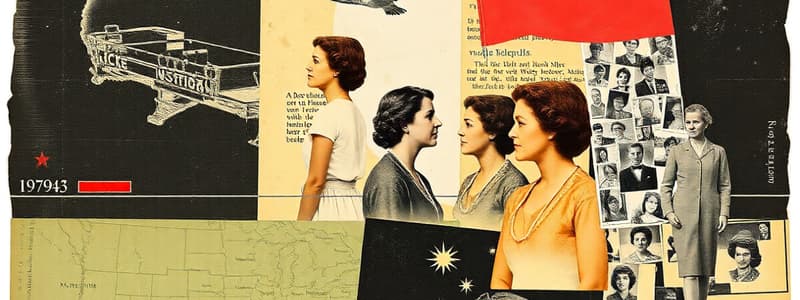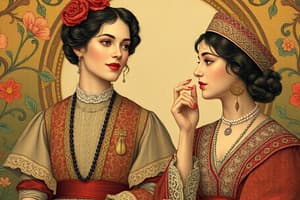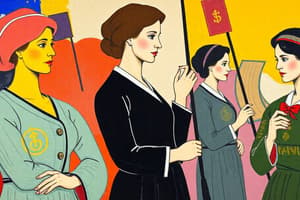Podcast
Questions and Answers
Which of the following events directly contributed to the formation of the National Woman Suffrage Association (NWSA) and the American Woman Suffrage Association (AWSA)?
Which of the following events directly contributed to the formation of the National Woman Suffrage Association (NWSA) and the American Woman Suffrage Association (AWSA)?
- The defeat of the first vote on women's suffrage in the U.S. Senate in 1887.
- The arrest of Susan B. Anthony in 1872 for voting in the presidential election.
- The passage of the Fourteenth Amendment in 1868, which denied voting rights to women.
- The split within the American Equal Rights Association (AERA) over the issue of voting rights for African American men. (correct)
The Anti-Suffrage Party, formed in 1871, opposed which of the following?
The Anti-Suffrage Party, formed in 1871, opposed which of the following?
- The enfranchisement of African American men through the Fifteenth Amendment.
- The inclusion of women in the World Anti-Slavery Convention in London.
- The right of women to vote in elections. (correct)
- The passage of the Fourteenth Amendment, which granted citizenship to all persons born in the United States, regardless of race or gender.
Which of the following territories was the first to grant women the right to vote, only to revoke it later?
Which of the following territories was the first to grant women the right to vote, only to revoke it later?
- Utah
- Washington (correct)
- Wyoming
- Colorado
The 1848 Seneca Falls Convention, a pivotal event in the women's suffrage movement, focused primarily on:
The 1848 Seneca Falls Convention, a pivotal event in the women's suffrage movement, focused primarily on:
What significance did the 1910 suffrage parade in New York City hold?
What significance did the 1910 suffrage parade in New York City hold?
The Supreme Court's decision in 1874 regarding the Fourteenth Amendment had what impact on the women's suffrage movement?
The Supreme Court's decision in 1874 regarding the Fourteenth Amendment had what impact on the women's suffrage movement?
Which of the following organizations played a significant role in advocating for women's suffrage, particularly during the early 20th century?
Which of the following organizations played a significant role in advocating for women's suffrage, particularly during the early 20th century?
Despite gaining women's suffrage in 1869, which territory experienced a temporary revocation of this right in 1887?
Despite gaining women's suffrage in 1869, which territory experienced a temporary revocation of this right in 1887?
Which of the following events occurred during the time period when the suffrage amendment passed through the House of Representatives and then the Senate, but before the state of New York granted women the vote?
Which of the following events occurred during the time period when the suffrage amendment passed through the House of Representatives and then the Senate, but before the state of New York granted women the vote?
Which of the following events happened in the same year that the National Woman's Party was formed?
Which of the following events happened in the same year that the National Woman's Party was formed?
Which event happened directly after Alaska Territory granted women suffrage?
Which event happened directly after Alaska Territory granted women suffrage?
In what chronological order did the following events occur? I. The March 3rd, 1913, Woman’s Suffrage Procession in Washington, DC, was attacked by a mob of angry, drunken men. II. The 1913 Alice Paul and Lucy Burns Congressional Committee for Woman Suffrage was formed as a subcommittee of NAWSA. III. Oregon, Kansas, and Arizona adopted women's suffrage. IV. The 1912 ‘Torchlight Parade’ of marchers, floats, chariots, and horses was held in New York City on Fifth Avenue.
In what chronological order did the following events occur? I. The March 3rd, 1913, Woman’s Suffrage Procession in Washington, DC, was attacked by a mob of angry, drunken men. II. The 1913 Alice Paul and Lucy Burns Congressional Committee for Woman Suffrage was formed as a subcommittee of NAWSA. III. Oregon, Kansas, and Arizona adopted women's suffrage. IV. The 1912 ‘Torchlight Parade’ of marchers, floats, chariots, and horses was held in New York City on Fifth Avenue.
Which of the following is NOT an accurate statement about the events surrounding the 'Night of Terror'?
Which of the following is NOT an accurate statement about the events surrounding the 'Night of Terror'?
Prior to the formation of the National Woman's Party, the suffragist organization with which Alice Paul was associated is:
Prior to the formation of the National Woman's Party, the suffragist organization with which Alice Paul was associated is:
Which year experienced two significant milestones in women's suffrage: a large parade in New York City and the adoption of women's suffrage in multiple states?
Which year experienced two significant milestones in women's suffrage: a large parade in New York City and the adoption of women's suffrage in multiple states?
Which event prompted President Woodrow Wilson to publicly back the constitutional amendment for women's suffrage?
Which event prompted President Woodrow Wilson to publicly back the constitutional amendment for women's suffrage?
Flashcards
Suffragists
Suffragists
A group of women advocating for the right to vote.
Torchlight Parade
Torchlight Parade
A march in which participants carried torches to illuminate the way.
Silent Sentinels
Silent Sentinels
A group of women who held silent protests outside the White House.
Force-feeding
Force-feeding
Signup and view all the flashcards
Jeannette Rankin
Jeannette Rankin
Signup and view all the flashcards
National Woman's Party (NWP)
National Woman's Party (NWP)
Signup and view all the flashcards
19th Amendment
19th Amendment
Signup and view all the flashcards
Woman's Suffrage Procession Attack
Woman's Suffrage Procession Attack
Signup and view all the flashcards
1840: London Convention Backlash
1840: London Convention Backlash
Signup and view all the flashcards
1848: Seneca Falls Convention
1848: Seneca Falls Convention
Signup and view all the flashcards
1868: Fourteenth Amendment & Male Suffrage
1868: Fourteenth Amendment & Male Suffrage
Signup and view all the flashcards
1869: Wyoming's Frontier Vote
1869: Wyoming's Frontier Vote
Signup and view all the flashcards
1870: Fifteenth Amendment and Women's Suffrage
1870: Fifteenth Amendment and Women's Suffrage
Signup and view all the flashcards
1872: Susan B. Anthony's Arrest
1872: Susan B. Anthony's Arrest
Signup and view all the flashcards
1890: NAWSA Formation
1890: NAWSA Formation
Signup and view all the flashcards
1893: Colorado's Vote for Women
1893: Colorado's Vote for Women
Signup and view all the flashcards
Study Notes
Woman Suffrage Timeline
- 1840: Women delegates barred from World Anti-Slavery Convention in London.
- 1848: First women's suffrage convention in Seneca Falls, NY.
- 1850: First nationwide women's rights convention in Worcester, MA.
- 1866: American Equal Rights Association (AERA) formed.
- 1868: Fourteenth Amendment grants citizenship but with "male" qualifier.
- 1869: AERA splits; Wyoming Territory grants women the vote.
- 1870: Fifteenth Amendment grants African American men the vote; Utah Territory women given the vote (later revoked).
- 1871: Anti-Suffrage Party created; women's right to vote debated.
- 1872: Susan B. Anthony arrested for voting.
- 1874: Supreme Court rules Fourteenth Amendment does not grant women the vote.
- 1878: Women's suffrage amendment first introduced in Congress.
- 1883: Washington Territory grants women the vote.
- 1887: Utah women's right to vote reinstated.
- 1890: Suffrage groups merge; National American Woman Suffrage Association (NAWSA) formed.
Further Timeline Progress
- 1893: Colorado grants women the vote.
- 1896: Idaho grants women the vote.
- 1902: Women from 10 countries meet to discuss suffrage in Washington D.C.
- 1907: Harriot Stanton Blatch organizes equality league.
- 1908: Suffragists march down Broadway, NYC despite restrictions.
- 1910: First large-scale suffrage parade in NYC.
- 1911: 3,000 suffragists parade in NYC.
- 1912: 10,000 then 15,000 suffragists march, including torchlight parades.
- 1913: Suffragists form committee, march in Washington DC; Oregon, Kansas, and Arizona adopt woman suffrage.
- 1914: Nevada and Montana grant women suffrage; larger NYC parade.
- 1916: NWP formed and begins demonstrating.
- 1917: 1,000 suffragists march around White House; violence during demonstrations. Suffragists gain support from a wider range of states.
- 1917: New York State gives women the vote.
- 1918: Suffragists protest violence occurring during marches. Woodrow Wilson supports the 19th amendment.
- 1919: Michigan, South Dakota, and Oklahoma grant women suffrage; federal suffrage amendment passes House and Senate.
- 1920: Tennessee ratifies the 19th Amendment; women gain the right to vote nationwide. However, some states took time to formally ratify, delaying the effect of the 19th Amendment.
Studying That Suits You
Use AI to generate personalized quizzes and flashcards to suit your learning preferences.




